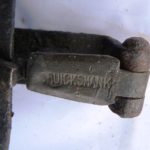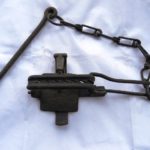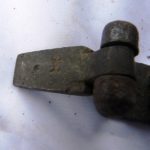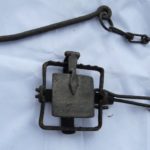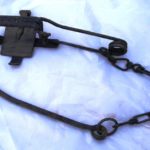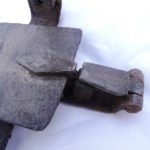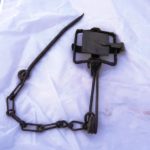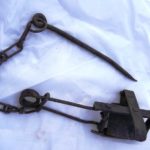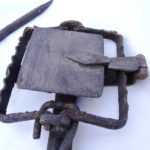4″ size Cruickshank gin trap – a revolutionary design which enables the spring to be replaced if ever necessary. Only a few of these traps were made and very rarely come available for sale. More details on the history of this design are given below along with a comprehensive gallery of photographs.
This particular specimen is in good working order with a strong spring and all joints moving freely. At some point it has been painted or coated which while in some respects unfortunate, has preserved the trap in good condition. The coating is showing signs of flaking which suggests it may be possible to remove without too much difficulty.
Located in Solihull and can be posted for a UK delivery fee of £10. Delivery outside the UK available by prearrangement.
How the Auction Works
SOLD
If a bid is received within 24 hours of the target end date, the end date will be extended to give a clear 24 hours between the last bid update on the listing and the end of the auction.
On completion the winning bidder will be contacted to complete the sale. Where the item is to be collected the buyer may be required to pay Vintage Traps a non-refundable 10% deposit, after which the details of collection and final payment will be released.
Items are sold ‘as seen’ – no refunds given or returns accepted
Before bidding you should check out the rules HERE and to place a bid just add a comment below with the value of your bid. Comments will visible on the listing so that everyone can see the value of the current highest bid and the nickname of the bidder. If you want to bid you’ll need to register which you can do in ‘My Account‘. If you want to place a practice bid just to see how it looks, have a go on our EXAMPLE.
On 19th September 1902 Patent application number 20,460 was made, and accepted on 13th August 1903. This application was for a single detachable wire spring for gin traps, “a has for its objects to enable such traps to be manufactured at considerably less cost than hitherto, whilst simultaneously giving greater power of spring, with facilities for detaching and renewing when worn or broken, ease in setting and durability in use, combined with extreme lightness as compared with the best known types in present use.”
The applicant for this patent was Alexander Allan Cruickshank of Atholl Cottage, Dumbarton, an Inland Revenue Officer by profession. The trap was made in two versions; one with the normal steel jaw and the other, a humane version, had rubber covered jaws.
Cruickshank’s traps only seem to have been made in 4 inch and 3 inch jaw sizes, and were advertised in Gilbertson & Page’s Ltd. 1913 catalogue at 28/- doz. (4 inch) and 23/6d doz. (3 inch) carriage paid.

